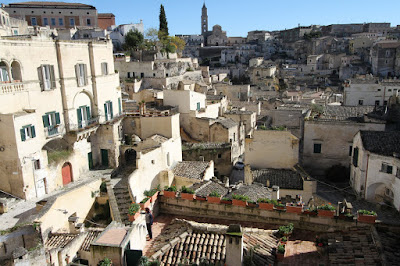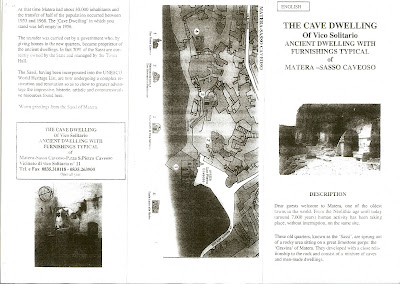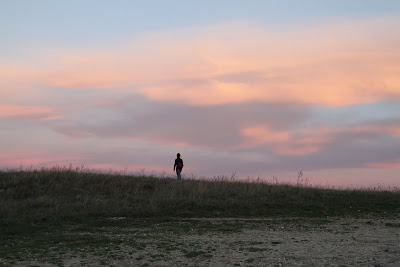We start out the day with a big fruit breakfast in our trullo (previous post) and then go down for a coffee and sweet pastry at Bar Aldo. After that, we head to Matera. What incredibly beautiful country. Could be the season we are in, but it's more lush than we imagined. In summer, perhaps it is a bit more parched. But today, there are wood thickets and rolling farmland interspersed. And it's all neat as a pin. Beautiful low stone walls everywhere - the stones removed from the fields have to go somewhere we guess. The day is cool and sunny, not a cloud in the sky.
We arrive in Matera, navigate approximately to where we think we should be (somewhere near Piazza Vittoria Veneto is a good starting point), park, and find a tourist info office to get a map. The Sassi di Matera means “the stones of Matera” are cave dwellings that were inhabited from prehistoric times up to the 1950s. The caves are in the old town of Matera in two sections: the Sasso Caveoso and the Sasso Barisano. We start at Piazza Vittoria Vento and walk east toward the ravine (the gravina) to see the cave dwellings. As we make our way there we pass through the layers of time, the dwellings above the ravine being the oldest part of the town. We explore for several hours and catch some of the highpoints. There are endless little nooks and crannies to explore. The town is quite proud of the fact that Mel Gibson's The Passion of the Christ (2004) was filmed here. Before Gibson, the same subject was treated by Pier Paolo Pasolini in Il vangelo secondo Matteo (1964) (The Gospel According to St. Matthew). One can see why the setting would work for these films. The dwelling (excavated and sculpted) can look quite primitive from the outside. We pop into a recreated house called Casa Grotta di vico Solotario - a typical house-cave, where animals and people lived. It doesn’t seem so bad, but we don’t live here. In some ways what’s presented at Casa Grotta seems ingenious in some ways; how they adapted to the conditions in these caves in terms of getting air and water in and waste out. The old town is a UNESCO site partially due to the ingenious ways water was captured and stored in cisterns in the rock for use in the hot, dry summers. There was a little museum called La Raccolta dell Acque that we missed that looked interesting.
Views of the town from various points are spectacular. Carlo Levi a Piemontese writer wrote about this area and the Sassi in his book Christo s'e fermato ad Eboli which dealt with his exile in the south because he was anti-fascist. Levi wrote the book in 1946 when people were still living in the Sassi. The title of his book means “Christ stopped at Eboli” meaning that this part of Italy is so backwards that not even Christ came here. He stopped at a town much more north. Only in the 1950s did the Italian government finally address the conditions in Matera and move people out. The old town is slowly coming back to life (shops, artisans, families) but its fate is uncertain.
Quote from Carlo Levi, Chapter 10:
“I set out at last to find the town. A little beyond the station I found a street with a row of houses on one side and on the other a deep gully. In the gully lay Matera. From where I was, higher up, it could be hardly be seen because the drop as so sheer. All I could distinguish as I looked down were alleys and terraces, which concealed the houses from view. Straight across from me there was a barren hill of an ugly gray color, without a trace or sign of cultivation upon it, nothing but sun-baked earth and stones. At the bottom of the gully a sickly, swampy stream, the Gravina, trickled among the rocks. The hill and the stream had a gloomy, evil appearance that caught at my heart. The gully had a strange shape: it was formed by two half-funnels, side by side, separated by a narrow spur and meeting at the bottom which I could see a white church, Santa Maria de Idris, which looked half-sunk in the group. The two funnels, I learned were called Sasso Caveoso and Sasso Barisano. They were like a schoolboys’s idea of Dante’s Inferno.”
And to think it was this book that inspired us to visit the Sassi! Not exactly copy for a tourist brochure?
For lunch we try Ristorante Lucanerie (Via S. Stefano 61) which is a very good choice. We sample local flavors in many little dishes. Pasta al ferretto (rolled around an iron rod) - with red sauce and bacala and with local broccoli, cheese and sausage. Almond semifreddo for dessert. We've run into a lot of semifreddo this trip. We return to the Sassi and explore a little more and the head off to the other side of the gorge across from the town to see the town from that perspective and explore some of the dwellings on that side. The gorge has a river running through it called Torrente Gravina di Matera.
Sassi and the Gravina
Looking South Across the Sassi

Looking North Across the Sassi

Piazza Vittorio Veneto - Matera

View of the Sassi from Piazza Vittorio Veneto
San Pietro Caveoso


Looking North Across the Sassi

Piazza Vittorio Veneto - Matera

View of the Sassi from Piazza Vittorio Veneto

San Pietro Caveoso















No comments:
Post a Comment
All comments go through a moderation process. Even though it may not look like the comment was accepted, it probably was. Check back in a day if you asked a question. Thanks!